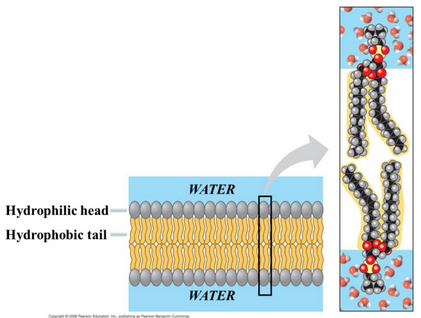10.4 Waxes and Other Complex Lipids

Figure 10.19: Formation of a Wax
Waxes are a kind of complex fatty acid that are formed from the esterification of fatty acids and long chain alcohols (see figure 10.19).
Waxes can be used in a variety of situations, including but not limited to:
- Comestics
- Candles
- Pharmaceuticals
- Polishing lubricants
10.4.1 Glycerophospholipids

Figure 10.20: Structure of a Glycerophospholipid
These are amphiphatic molecules - they have a hydrophobic and a hydrophilic region (see figure 10.20).
Figure 10.21: Common Hydrophilic Groups in Glycerophospholipids
Figure 10.21 displays several common hydrophilic groups that are present in glyceryophospholipids.
10.4.2 Sphingolipids and glycosphingolipids
Figure 10.22: Structure of a Sphingolipid and a Glycosphingolipid
Figure 10.22 displays an example of a sphingolipid (left) and a glycosphingolipid (right).
In some membrane lipids built on top of a sphingosine molecule, the head group of the sphingosine molecule has saccharides. The general name for these kinds of lipids are called glycolipids.
10.4.3 Glycoglycerolipids
Figure 10.23: A Glycoglycerolipid
This is another class of less-common lipids (see figure 10.23 for an example) in animal cell membranes, but are widespread in plant and bacterial cell membranes.
10.4.4 Sterols and steroids
Sterols are present in both plants and animals. In animals, sterols are present in the cell membranes (i.e., cholesterol - see figure 10.24).
Figure 10.24: Cholsterol and Isoprene Comparison
Steroids are a large group of substances for which cholesterol is a biosynthetic precursor. Steroids also vary in function according to their functional groups.